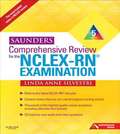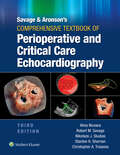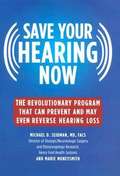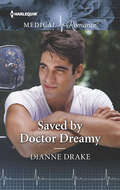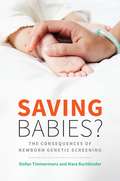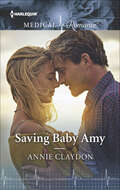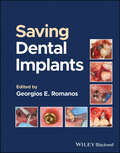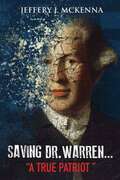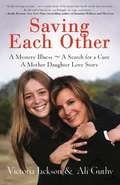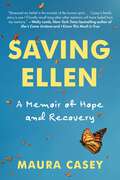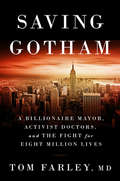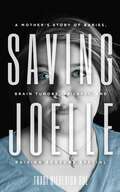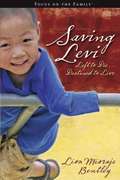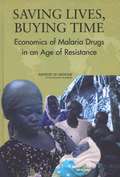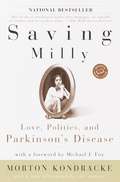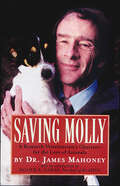- Table View
- List View
Saunders Comprehensive Review for the NCLEX-RN® Examination
by Linda Anne SilvestriThis title includes additional digital media when purchased in print format. For this digital book edition, media content is not included.
Savage & Aronson's Comprehensive Textbook of Perioperative and Critical Care Echocardiography
by Alina Nicoara Robert M. Savage Nikolaos J. Skubas Stanton K. Shernan Christopher A. TroianosThoroughly revised to reflect new advances in the field, Savage & Aronson’s Comprehensive Textbook of Perioperative and Critical Care Echocardiography, Third Edition, remains the definitive text and reference on transesophageal echocardiography (TEE). Edited by Drs. Alina Nicoara, Robert M. Savage, Nikolaos J. Skubas, Stanton K. Shernan, and Christopher A. Troianos, this authoritative reference covers material relevant for daily clinical practice in operating rooms and procedural areas, preparation for certification examinations, use of echocardiography in the critical care setting, and advanced applications relevant to current certification and practice guidelines.
Savage Son: the gripping, thrilling and adventurous novel in the James Reece series (Terminal List #3)
by Jack Carr**SOON TO BE A TV SERIES STARRING CHRIS PRATT**'Carr writes both from the gut and a seemingly infinite reservoir of knowledge in the methods of human combat. Loved it!' Chris Hauty, bestselling author of Deep State Deep in the wilds of Siberia, a woman is on the run, pursued by a man harboring secrets – a man intent on killing her. Half a world away, James Reece is recovering from brain surgery in the Montana wilderness, slowly putting his life back together with the help of investigative journalist Katie Buranek and his longtime friend and SEAL teammate Raife Hastings. Unbeknown to them, the Russian mafia has set their sights on Reece in a deadly game of cat and mouse.In his most visceral and heart-pounding thriller yet, Jack Carr explores the darkest instincts of humanity through the eyes of a man who has seen both the best and the worst of it.Praise for Jack Carr: 'This is seriously good . . . the suspense is unrelenting, and the tradecraft is so authentic the government will probably ban it – so read it while you can!' Lee Child 'With a particular line in authentic tradecraft, this fabulously unrelenting thrill-ride was a struggle to put down' Mark Dawson 'Gritty, raw and brilliant!' Tom Marcus &‘So powerful, so pulse-pounding, so well-written – rarely do you read a debut novel this damn good&’ Brad Thor 'A powerful, thoughtful, realistic, at times terrifying thriller that I could not put down. A terrific addition to the genre, Jack Carr and his alter-ego protagonist, James Reece, continue to blow me away' Mark Greaney 'Thrilling' Publishers Weekly
Savage Will
by Timothy M. GaySavage Will brings to life a remarkable story of perseverance, heroism, and survival: the true tale of the American medics and nurses who endured two months in Nazi-occupied Albania-and the fearless citizens and Allied intelligence officers who risked all to save them. On a cold morning in war-ravaged Sicily in 1943, men and women of the 807th Medical Air Evacuation Squadron boarded a routine flight to the Italian mainland to care for wounded soldiers. En route, their plane became lost in storm clouds looming over the Adriatic Sea, drifted hundreds of miles off course, and crash-landed in remote mountainous Albania. Stranded without proper winter clothing or weapons, the Americans were trapped hundreds blizzard-plagued miles from Allied lines in a country torn apart by rival bands of pro- and anti-German guerrillas. What followed is the most thrilling untold story of World War II-a saga that would ensnare a cast of hundreds, from President Roosevelt and top Allied intelligence officials to a host of brave Albanian Resistance fighters, the British and U. S. Mediterranean air forces, and the gritty officers sent behind enemy lines to rescue them: a dashing English lieutenant and a tenacious American captain. Hunted by German soldiers, the American castaways were forced to rely on what one survivor called their "savage will" to elude their enemy and ultimately find their way to freedom. Savage Will is a testament to a generation who defied all odds.
Save Your Hearing Now
by Michael D. Seidman Marie MoneysmithAfter 20 years of research, leading otolaryngologist Dr. Seidman has developed a breakthrough all-natural alternative treatment program to battle hearing loss safely and effectively.
Save Your Sight!: Natural Ways to Prevent and Reverse Macular Degeneration
by Michael R. Rose Marc R. RoseMacular degeneration, an affliction of progressive vision loss, is the leading cause of blindness in the United States. This remarkable volume shows how diet, nutritional supplements, exercise and certain lifestyle choices can halt, reverse, or even prevent the onslaught of this devastating disease.
Saved by Doctor Dreamy
by Dianne DrakeA big city doctor finds adventure and untamable passion in the jungles of costa Rica in this heartwarming medical romance.Finally ready to escape her father’s shadow, Dr. Juliette Allen heads to Costa Rica to claim her independence. But her time abroad is for chasing adventure . . . not facing the constant temptation of her sexy, arrogant new boss, Damien Caldwell!Damien can’t understand why gorgeous, fiery Juliette would hide herself away in the jungle. But he quickly learns not to underestimate the quiet strength of this auburn beauty. And when tragedy strikes, Damien finds himself on an unexpected mission—to open Juliette’s heart and convince her to take a chance on love!
Saved by Their Miracle Baby: Awakening The Shy Nurse (medics, Sisters, Brides) / Saved By Their Miracle Baby (medics, Sisters, Brides) (Medics, Sisters, Brides #2)
by Alison RobertsFriends to short-term lovers…Could a miracle unite them forever?Surgeon Noah only expected one night of abandon with physiotherapist Abby. But crossing the line of friendship ignited a hidden chemistry…leaving Abby pregnant and the once carefree Noah struck by memories of his painful past. But when his son’s premature arrival makes him a father sooner than expected, Noah must fight against the odds to become the man his family deserves…A Medics, Sisters, Brides novelMedics, Sisters, Brides duetBook 1 — Awakening the Shy Nurse Book 2 — Saved by Their Miracle Baby “Overall, Ms. Roberts has delivered a delightful read in this book where the chemistry between this couple was strong from the moment they meet…the romance was heart-warming….”—Harlequin Junkie on Melting the Trauma Doc’s Heart“I read this in one sitting. This was such a heart-felt story. I loved the characters. The author really did a fantastic job…. I highly recommend this story to anyone. It was a real treat to read.”—Goodreads on Pregnant with Her Best Friend’s Baby
Saving Babies?: The Consequences of Newborn Genetic Screening
by Stefan Timmermans Mara BuchbinderIt has been close to six decades since Watson and Crick discovered the structure of DNA and more than ten years since the human genome was decoded. Today, through the collection and analysis of a small blood sample, every baby born in the United States is screened for more than fifty genetic disorders. Though the early detection of these abnormalities can potentially save lives, the test also has a high percentage of false positives--inaccurate results that can take a brutal emotional toll on parents before they are corrected. Now some doctors are questioning whether the benefits of these screenings outweigh the stress and pain they sometimes produce. In Saving Babies?, Stefan Timmermans and Mara Buchbinder evaluate the consequences and benefits of state-mandated newborn screening--and the larger policy questions they raise about the inherent inequalities in American medical care that limit the effectiveness of this potentially lifesaving technology. Drawing on observations and interviews with families, doctors, and policy actors, Timmermans and Buchbinder have given us the first ethnographic study of how parents and geneticists resolve the many uncertainties in screening newborns. Ideal for scholars of medicine, public health, and public policy, this book is destined to become a classic in its field.
Saving Baby Amy: The Doctor's Secret Son Reforming The Playboy Doc Saving Baby Amy (Large Print Medical Romance Ser. #Vol. 900)
by Annie ClaydonBrought together… and bound forever! Fiercely independent orthopedic doctor Chloe Delancourt will do anything for her teenage sister, Hannah, and little niece, Amy. So when Amy falls ill and Hannah runs away, Chloe steps in, with the help of gorgeous pediatrician Jon Lambert…igniting an unexpected attraction! Saving baby Amy brings Jon closer than he ever wanted to get to another woman after his disastrous marriage. But Chloe&’s determination and unwavering loyalty remind Jon of what a real family should be…and that this could be his chance to have everything with Chloe!
Saving Dental Implants
by Georgios E. RomanosComprehensive, multidisciplinary approach to all aspects of dental implant maintenance, based on treatment outcomes Saving Dental Implants offers a complete reference to all factors in long-term success in dental implants. Taking an interdisciplinary approach, each chapter is written by leading experts in the field. The book examines treatment outcomes, provides advice on how to manage implants for long-term success, and supports clinicians in avoiding and managing peri-implant complications. The text presents global treatment approaches and concepts—established philosophies in practice for the last 20 years—and also looks to possible future management strategies. Designed to help clinicians apply the concepts in practice, the text also covers the pros and cons of implant therapy and the specifics of pre-implant diagnostics, treatment methodology, prosthetic concepts, and further maintenance visits. Featuring hundreds of high-quality color photographs to support the text, Saving Dental Implants covers topics such as: The anatomic features of peri-implant tissues, including clinical and histological information, and an evaluation of the studies using different implant systems and prosthetic concepts Diagnostic tools and procedures to make the proper diagnosis of peri-implant conditions, and microbiota of the peri-implant tissues and diagnostic opportunities for bacterial diagnosis Nanoparticles found in the peri-implant tissues from the implant placement, their loading, and their impact on peri-implant diseases The significance, applications, and limitations of bone grafting techniques to optimize the shape of the alveolar ridge New technologies for better treatment of peri-implant complicationsExamining the most current information and research on diagnosing, preventing, and managing peri-implant complications, Saving Dental Implants is a must-have practical reference for dental practitioners, specialists, and students who wish to help patients reach the best functional and esthetic outcomes.
Saving Dr. Warren ... A True Patriot
by Jeff McKennaSteve O'Dell loves to write and does it well. But as an eighth-grade student at Needham Middle School, his talent sometimes seems more an embarrassment than a blessing. <p><p> Then, on Veterans Day 2001, Steve’s award-winning essay propels him into an adventure twisting through Revolutionary battles and bloodshed. Thanks to the bizarre bequest of a manuscript and a musket ball from a long-lost family war hero, Steve’s journey with the Revolutionary War hero Dr. Joseph Warren begins. <p><p> A time-traveling talisman missing from the archives of one of Boston’s oldest historical societies takes Steve through portals of history, where he walks side by side with a real Boston patriot. He makes house calls with Dr. Warren on March 5, 1770 and stumbles onto the bloodstained streets of the Boston Massacre. <p><p>From the killings of March 5, to boarding tea ships in 1773, Steve’s history book explodes to life as he helps Dr. Warren and forges a friendship with Boston’s True Patriot. Steve watches Dr. Warren launch Paul Revere on his midnight ride, and he helps Dr. Warren dodge British musket balls in the first battles of the War for Independence. With each adventure, Steve tastes the light that ignites The Revolution. <p><p> Steve will eventually convince others that the Revolutionary relic he was given really does open portals through time, but he faces his most difficult quest alone—saving Dr. Warren from the onslaught at Bunker Hill. Can he do it? And if he fails, will he ever return to this century? <p><p> Saving Dr. Warren...A True Patriot rips through the pages of history. From the Revolutionary War to the vanishing veterans of World War II, to the ashes of September 11, 2001, Saving Dr. Warren demonstrates to both old and young that patriotism, standing like an old oak tree on a grandfather’s farm, has and will endure.
Saving Each Other
by Victoria Jackson Ali GuthyOn the surface, Victoria Jackson is the American Dream personified: from a troubled childhood and unfinished high school education, she overcame immeasurable odds to create a cosmetics empire valued at more than half a billion dollars. Married to Bill Guthy - self-made principal of infomercial marketing giant Guthy-Renker - Victoria's most treasured role is mother to three beautiful, beloved children, Evan, Ali, and Jackson. Suddenly, Victoria's dream life is broken as she begins to battle a mother's greatest fear. In 2008, her daughter, Ali, began experiencing unusual symptoms of blurred vision and an ache in her eye. Ali's test results led to the diagnosis of Neuromyelitis Optica. NMO is is a little understood, incurable, and often fatal autoimmune disease that can cause blindness, paralysis, and life-threatening seizures, and afflicts as few as 20,000 people in the world. At the age of 14, Ali was given a terrifying prognosis of four to six years to live. Saving Each Other: A Mother Daughter Love Storybegins just as Victoria and Bill learn of Ali's disease, starting them on a powerful journey to save Ali, their only daughter, including bringing together a team of more than fifty of the world's leading experts in autoimmune and NMO-related diseases to create the Guthy-Jackson Charitable Foundation. Told in alternating viewpoints, Victoria and Ali narrate their very different journeys of coming to terms with the lack of control that neither mother nor daughter have over NMO, and their pioneering efforts and courage to take their fight to a global level. Bringing their story to light with raw emotion, humor, warmth, and refreshing candor, Saving Each Other is the extraordinary journey of a mother and daughter who demonstrate how the power of love can transcend our greatest fears, while at the same time battling to find a cure for the incurable.
Saving Each Other
by Victoria Jackson Ali GuthyOn the surface, Victoria Jackson is the American Dream personified: from a troubled childhood and unfinished high school education, she overcame immeasurable odds to create a cosmetics empire valued at more than half a billion dollars. Married to Bill Guthy--self-made principal of infomercial marketing giant Guthy-Renker--Victoria's most treasured role is mother to three beautiful, beloved children, Evan, Ali, and Jackson.Suddenly, Victoria's dream life is broken as she begins to battle a mother's greatest fear. In 2008, her daughter, Ali, began experiencing unusual symptoms of blurred vision and an ache in her eye. Ali's test results led to the diagnosis of Neuromyelitis Optica. NMO is is a little understood, incurable, and often fatal autoimmune disease that can cause blindness, paralysis, and life-threatening seizures, and afflicts as few as 20,000 people in the world. At the age of 14, Ali was given a terrifying prognosis of four to six years to live.Saving Each Other: A Mother Daughter Love Story begins just as Victoria and Bill learn of Ali's disease, starting them on a powerful journey to save Ali, their only daughter, including bringing together a team of more than fifty of the world's leading experts in autoimmune and NMO-related diseases tocreate the Guthy-Jackson Charitable Foundation.Told in alternating viewpoints, Victoria and Ali narrate their very different journeys of coming to terms with the lack of control that neither mother nor daughter have over NMO, and their pioneering efforts and courage to take their fight to a global level.Bringing their story to light with raw emotion, humor, warmth, and refreshing candor, Saving Each Other is the extraordinary journey of a mother and daughter who demonstrate how the power of love can transcend our greatest fears, while at the same time battling to find a cure for the incurable.
Saving Each Other
by Victoria Jackson Ali GuthyOn the surface, Victoria Jackson is the American Dream personified: from a troubled childhood and unfinished high school education, she overcame immeasurable odds to create a cosmetics empire valued at more than half a billion dollars. Married to Bill GuthyOCoself-made principal of infomercial marketing giant Guthy-RenkerOCoVictoriaOCOs most treasured role is mother to three beautiful, beloved children, Evan, Ali, and Jackson. Suddenly, VictoriaOCOs dream life is broken as she begins to battle a motherOCOs greatest fear. In 2008, her daughter, Ali, began experiencing unusual symptoms of blurred vision and an ache in her eye. AliOCOs test results led to the diagnosis of Neuromyelitis Optica. NMO is is a little understood, incurable, and often fatal autoimmune disease that can cause blindness, paralysis, and life-threatening seizures, and afflicts as few as 20,000 people in the world. At the age of 14, Ali was given a terrifying prognosis of four to six years to live. "Saving Each Other: A Mother Daughter Love Story" begins just as Victoria and Bill learn of AliOCOs disease, starting them on a powerful journey to save Ali, their only daughter, including bringing together a team of more than fifty of the worldOCOs leading experts in autoimmune and NMO-related diseases tocreate the Guthy-Jackson Charitable Foundation. Told in alternating viewpoints, Victoria and Ali narrate their very different journeys of coming to terms with the lack of control that neither mother nor daughter have over NMO, and their pioneering efforts and courage to take their fight to a global level. Bringing their story to light with raw emotion, humor, warmth, and refreshing candor, Saving Each Other is the extraordinary journey of a mother and daughter who demonstrate how the power of love can transcend our greatest fears, while at the same time battling to find a cure for the incurable. "
Saving Ellen: A Memoir of Hope and Recovery
by Maura CaseyA coming-of-age memoir that follows a large, working-class Irish family as it plunges into chaos in the wake of a terminal diagnosis—and the author's own hidden struggle to endure when her sister's disease becomes the dark star around which they all revolve. Financial privation and her father&’s drunken scenes formed the backdrop to Maura Casey's childhood, but her sister Ellen&’s years-long struggle with kidney disease consumed her whole family. Determined to see Ellen live to adulthood, her mother fought medical advice to donate a kidney at a time when organ transplants were medical miracles. She concealed the true impact of that decision, which would affect the family for years to come. Set in Buffalo amidst the tumult of the 1960s and 70s, Saving Ellen traces the author's recovery from alcoholism and sexual assault and tells of her irrepressible older sister Ellen, who fought to claim her dream of becoming an athlete; her smart, feminist mother, whose World War II Army service prepared her to manage her own platoon of six children; and her adulterous, alcoholic father who, at the end, was haunted by his shortcomings and regrets. Despite the hard truths of her childhood, Saving Ellen is ultimately a story of humor at unexpected moments as well as the grace of reconciliation and gratitude.Saving Ellen will appeal to those who have endured the stress of caring for a chronically ill family member, with all the fraught choices that entails. Readers who have experienced the unique insanity of living in a large alcoholic family will recognize the mix of madness and humor that forms the foundation of daily life. Casey's story has parallels to Monica Wood&’s When We Were the Kennedys, which details the struggle her family began when her father died of a heart attack, and Jeannette Walls&’ The Glass Castle, with its tale of family dysfunction and siblings trying to help one another cope in a dilapidated house with an unstable father.
Saving Gotham
by Tom FarleyIn 2002, a dynamic doctor named Thomas Frieden became health commissioner of New York City. With support from the new mayor, billionaire Michael Bloomberg, Frieden and his health department team prohibited smoking in bars, outlawed trans fats in restaurants, and attempted to cap the size of sodas, among other groundbreaking actions. The initiatives drew heated criticism, but they worked: by 2011, 450,000 people had quit smoking, childhood obesity rates were falling, and life expectancy was growing. Saving Gotham is the behind-the-scenes story of the most controversial--and successful--public health initiative of our time. Thomas A. Farley, MD, who succeeded Frieden as health commissioner, introduces a team of doctors who accepted the challenge of public health: to care for each of New York City's eight million inhabitants as their own patients. The biggest threats they faced were not cholera or chemical toxins or lack of medical care but instead habits like smoking and unhealthy eating. As these doctors pressed to solve these problems, they found themselves battling those who encouraged those habits, and they reshaped their own agency for a different sort of fight. Farley shows what happens when science-driven doctors are given the political cover to make society-wide changes to protect people from today's health risks--and how industries exploit legislatures, the courts, the media, and public opinion to undermine them. With Washington caught in partisan paralysis and New York City's ideas spreading around the world, Saving Gotham demonstrates how government--local government--can protect its citizens and transform health for everyone.
Saving Jane Doe: A Novel
by Carolyn PurcellAn unplanned pregnancy triggers a woman&’s emotional journey in this &“intense&” and inspiring novel of healing and forgiveness (Lexington Herald Leader). At a seedy Lexington motel, a &“Jane Doe&” has been found unconscious, suffering from amnesia, and clinging to life after getting an illegal abortion. To Dr. Cara Land, third-year medical student at University of Kentucky Hospital, the patient has also become a friend she&’s desperate to help. When she discovers the woman&’s name is Jessica, it&’s the first step in her search for a vanished life. Now that Cara&’s compassionate Uncle Henry hires her a live-in housekeeper, the penniless Jessica—once adrift—has a tenuous hope for the future. However, as Jessica&’s past slowly comes into focus so do the memories of all she left behind—the husband and children she abandoned, the guilt and shame she&’s been trying to outrun, and the fear that there&’s no going back. But Jessica has a lot to discover about herself, those she loves, and the power of faith, family and forgiveness.
Saving Joelle: A Mother's Story of Babies, Brain Tumors, Epilepsy, and Raising Someone Special
by Traci Diederich RueIn Saving Joelle, a mother recounts the struggles faced by her oldest daughter, her family and herself. Little was known about their daughter's rare brain tumor, leading the parents to tirelessly search the world in hope of a cure. As if the tumor wasn't enough, their growing family struggled with multiple setbacks including other grim medical issues. Saving Joelle will take you through years of heart wrenching decisions made by this brave family and reflect on their continued journey to overcome each obstacle. Their story explores the meaning of love, hope, and their resilience in raising a child with special needs.
Saving Levi: Left to Die, Destined to Live
by Lisa Misraje BentleyA baby boy is found in a field in China. He has been burned over most of his body and left to die in is burial clothes. This is the story of an American famly running an orphanage for Chinese special-needs children. They recover the child from a chinese man. The Americans save him first in hospitals in China and then, through help from all over the world and their belief in God, bring the baby to the U.S. for treatment.
Saving Lives, Buying Time: Economics of Malaria Drugs in an Age of Resistance
by Institute of Medicine of the National AcademiesFor more than 50 years, low-cost antimalarial drugs silently saved millions of lives and cured billions of debilitating infections. Today, however, these drugs no longer work against the deadliest form of malaria that exists throughout the world. Malaria deaths in sub-Saharan Africa—currently just over one million per year—are rising because of increased resistance to the old, inexpensive drugs. Although effective new drugs called “artemisinins” are available, they are unaffordable for the majority of the affected population, even at a cost of one dollar per course. Saving Lives, Buying Time: Economics of Malaria Drugs in an Age of Resistance examines the history of malaria treatments, provides an overview of the current drug crisis, and offers recommendations on maximizing access to and effectiveness of antimalarial drugs. The book finds that most people in endemic countries will not have access to currently effective combination treatments, which should include an artemisinin, without financing from the global community. Without funding for effective treatment, malaria mortality could double over the next 10 to 20 years and transmission will intensify.
Saving Maddie's Baby
by Marion LennoxA precious rescue... Dr. Maddie Haddon doesn't think twice before running into Wildfire Island's gold mine to save a life. But another rockfall leaves Maddie trapped inside-and this time it's her turn to be saved... Emergency medic Josh Campbell is used to working under pressure, but when he discovers that his latest call is to rescue his ex-wife, who is on the brink of labor, the stakes are higher than ever! Can Josh save Maddie and her baby...and heal their broken marriage, too?
Saving Max
by Antoinette van HeugtenMax Parkman is perfect in his mother's eyes. Until he's accused of murder. Attorney Danielle Parkman can't deny her son's behavior has been getting worse—drugs and violent outbursts have become a frightening routine. But when she receives the diagnosis from a top-notch adolescent psychiatric facility that Max is deeply disturbed—and dangerous—it seems too devastating to accept. Until she finds Max, weapon in hand, at the bedside of a fellow patient who has been brutally stabbed to death. Separated from Max and trapped in a maelstrom of doubt and fear, Danielle's mothering instincts snap sharply into focus. The justice system is bearing down on her son, so she must use her years of legal experience to find out the truth, no matter what that might be. But has she, too, lost touch with reality? Is her son truly a killer?Previously published.
Saving Milly: Love, Politics, and Parkinson's Disease
by Morton KondrackeFrom the book: "Deeply affecting . . . Unforgettable . . . Kondracke seems to be a natural truth-teller, and the directness of his narrative, its demotic lack of interest in irony when confronted with the rudimentary facts of mortal illness, opens his reader's heart and engages his reader's mind." -The New Republic "This is Morton Kondracke's account of his wife's battle with Parkinson's disease and his own transformation from a self-described careerist with more drive than talent to a mensch who has achieved greatness in this one book alone. I finished it last night in tears." -RICHARD COHEN, The Washington Post "Morton's love for Milly has been unfailingly strong and steadfast ... in sickness and in health. His fierce devotion has inspired him to move mountains, and move scientists closer than ever to finding a cure for this cruel disease. We all must join together to fight for more money so we can save our most precious resource-the lives of those we love." -KATIE COURIC
Saving Molly: A Research Veterinarian's Choices—for the Love of Animals
by Roger A. Caras James MahoneyThe puppy was on the verge of death when James Mahoney found her. Molly was not the first dying animal the research veterinarian had seen—but her struggle touched his heart, and sent him barreling over rough Jamaican mountains in a borrowed car during his vacation, searching for the equipment he’d need to save her. Saving Molly is not only the story of a rescued dog, but also of a rescued man. As he cares for the runt of the litter and raises her, he asks himself questions: How can he spend his days with chimpanzees locked behind bars and still say that he loves them? What do we owe them for their participation in medical research? Why is saving a single puppy important? In this “well-written, engaging book,” James Mahoney reflects on his early attraction to veterinary medicine, when he dreamed of being a horse doctor in Ireland; the debates both within his field and within his own mind about what’s right and wrong when it comes to laboratory work; and what he’s learned from fifty years of living with animals—and with the two-legged primates who study them (Library Journal). Written by the man Jane Goodall called “one of the most gentle and compassionate people I know,” Saving Molly is an important addition to the debate on animal research and a heartfelt meditation on one man’s life. It includes an introduction by Roger A. Caras, president of the ASPCA.
